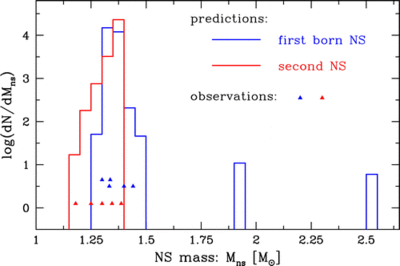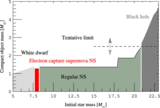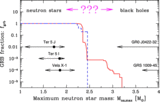Image Details

Caption: Fig. 3.
Predicted mass distribution for neutron stars in merging double neutron star binaries. Firstborn neutron stars are slightly heavier as they can accrete some matter from their unevolved binary companions. Population synthesis models (red and blue lines) are shown along with measured neutron star masses for the known double neutron star binaries. Although more observations are needed to constrain the shape of this distribution, the mass ranges of observed and predicted systems are in agreement. We use direct mass estimates for B1913+16, B1534+12, J0737−3039, and J1756−2251 (O’Shaughnessy et al. 2008), while for J1906+0746 we assume that both neutron stars have masses of ﹩1.3\,M_{\odot }﹩ (total system mass is ﹩2.6\,M_{\odot }﹩; Lorimer et al. 2006). The few compact objects found in our simulations with masses as high as ﹩2.5\,M_{\odot }﹩ may well be low‐mass black holes (see also Fig. 1).
Copyright and Terms & Conditions
© 2008. The American Astronomical Society. All rights reserved. Printed in U.S.A.






